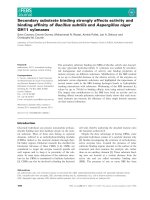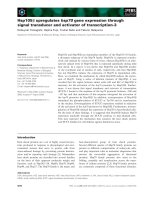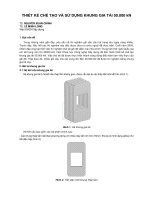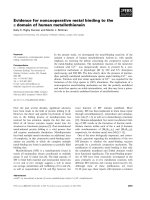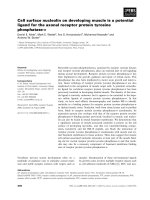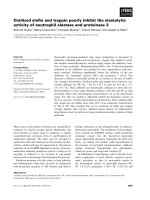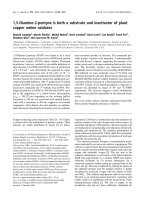Báo cáo khoa học: Post-ischemic brain damage: NF-jB dimer heterogeneity as a molecular determinant of neuron vulnerability pdf
Bạn đang xem bản rút gọn của tài liệu. Xem và tải ngay bản đầy đủ của tài liệu tại đây (254.45 KB, 9 trang )
MINIREVIEW
Post-ischemic brain damage: NF-jB dimer heterogeneity as
a molecular determinant of neuron vulnerability
Marina Pizzi
1,2
, Ilenia Sarnico
1
, Annamaria Lanzillotta
1
, Leontino Battistin
3
and PierFranco Spano
1,2
1 Division of Pharmacology and Experimental Therapeutics, Department of Biomedical Sciences and Biotechnologies, School of Medicine,
University of Brescia, Italy
2 National Institute of Neuroscience, Turin, Italy
3 IRCCS San Camillo Hospital, Venice, Italy
Stroke is the third major cause of death and long-term
disability in most developed countries, with very lim-
ited chance for effective treatments. The mechanisms
that trigger ischemic brain damage include a plethora
of biochemical and cellular events, such as glutamate-
mediated excitotoxicity, generation of reactive oxygen
species, DNA damage and inflammation. In focal
ischemia, primary neuronal death appears rapidly in
the core area and is followed by secondary death in
the ischemic penumbra that evolves from the delayed
activation of multiple death pathways. Thus, the
infarct takes several days to mature and recruits a
myriad of processes that, depending on the threshold
of single neuron vulnerability, determine the final dam-
age entity. Identifying the factors setting the limit of
neuronal resistance will disclose new targets for mini-
mizing development of the lesion. A large repertoire of
genes is activated by transcription factors induced in
brain ischemia, including hypoxia inducible factor-1,
p53, interferon regulatory factor-1 activating transcrip-
tion factor-2, signal transducer and activator of tran-
scription 3 and nuclear factor-kappaB (NF-j B) [1].
NF-jB is a key regulator of both inflammation and
cell death and has been proposed as suitable target for
Keywords
Bcl-xL; Bim; brain ischemia; cell death; c-Rel;
leptin; neurodegeneration; nuclear factor-
kappaB; oxygen glucose deprivation; p65
Correspondence
M. Pizzi, Associate Professor of
Pharmacology, Department of Biomedical
Sciences and Biotechnologies, School of
Medicine, University of Brescia, V.le Europa,
11, 25123 Brescia, Italy
Fax: +39 (030) 3717529
Tel: +39 (030) 3717501
E-mail:
(Received 30 June 2008, revised 12 October
2008, accepted 29 October 2008)
doi:10.1111/j.1742-4658.2008.06767.x
Nuclear factor-kappaB (NF-jB) has been proposed to serve a dual func-
tion as a regulator of neuron survival in pathological conditions associated
with neurodegeneration. NF-jB is a transcription family of factors com-
prising five different proteins, namely p50, RelA ⁄ p65, c-Rel, RelB and p52,
which can combine differently to form active dimers in response to external
stimuli. Recent research shows that diverse NF-jB dimers lead to cell death
or cell survival in neurons exposed to ischemic injury. While the p50 ⁄ p65
dimer participates in the pathogenesis of post-ischemic injury by inducing
pro-apoptotic gene expression, c-Rel-containing dimers increase neuron
resistance to ischemia by inducing anti-apoptotic gene transcription. We
present, in this report, the latest findings and consider the therapeutic
potential of targeting different NF-jB dimers to limit ischemia-associated
neurodegeneration.
Abbreviations
Bcl-2, B-cell lymphoma 2; IKK, IjB kinase; IL, interleukin; IjB, jB inhibitory protein; LTD, long-term depression; MCAO, middle cerebral
artery occlusion; MEK, mitogen-activated protein kinase kinase; mGlu, metabotropic glutamate; NF-jB, nuclear factor-kappaB; NMDA,
N-methyl-
D-aspartate; OGD, oxygen-glucose deprivation; PI3K, phosphatidylinositol 3-kinase; PKC, protein kinase C; RHD, Rel-homology
domain; TNFR, tumor necrosis factor receptor; TWEAK, tumor necrosis factor-like weak inducer of apoptosis.
FEBS Journal 276 (2009) 27–35 Journal compilation ª 2008 FEBS. No claim to original Italian government works 27
the treatment of brain ischemia [1–3]. In this report we
review the most recent advances in understanding the
mechanisms responsible for the dual effect produced
by NF-jB in the post-ischemic injury and for predict-
ing possible new experimental approaches.
Molecular activation of NF-jB
In the past two decades, much work focused on
NF-jB family proteins has proposed this ubiquitously
expressed transcription factor as a pleiotropic regulator
of target genes controlling physiological function in
the nervous system. In mammals, the NF-jB family
comprises five members, sharing an N-terminal 300
amino acid Rel-homology domain (RHD), which is
identical in 35–61% of all NF-jB family proteins: p65
(RelA), RelB, c-Rel, p50 ⁄ p105 (NF-jB1), and
p52 ⁄ p100, which are encoded by RELA, RELB, REL,
NFKB1 and NFKB2 respectively. The RHD domain
allows dimerization, nuclear translocation and DNA
binding. Among the members of the NF-jB family,
only p65, c-Rel and RelB are directly able to activate
the transcription of target genes. The transcriptional
capacities of p50 and p52, which are initially synthe-
sized as large precursors called p105 and p100, are
dependent on dimerization with p65, c-Rel or RelB
[4,5]. In the absence of stimuli, the members of the
NF-jB family form homodimers and heterodimers that
are present in an inactive state in the cytoplasm bound
to the jB inhibitory proteins (IjBs) (IjBa,IjBb,IjBe,
IjBc and Bcl-3, IjBf, the precursor proteins p100 and
p105), which share multiple ankyrin repeat domains
necessary for interacting with the RHD. In the estab-
lished model, these proteins retain NF-jB dimers in
the cytoplasm by masking the NF-jB nuclear localiza-
tion sequence and the DNA-binding domain. Indeed,
IjBa leads a constant shuttling of the p50 ⁄ p65 com-
plex between the nucleus and the cytoplasm [6]. In
stimulated cells, IjBa is phosphorylated and degraded,
thus favouring the nuclear localization of the NF-jB
complex where it binds to jB sites with the consensus
sequence GGGRNNYYCC (N = any base, R = pur-
ine, Y = pyrimidine) and activates the transcription of
a number of target genes. Among the numerous genes
regulated by NF-jBisIjBa. Newly synthesized IjBa
can enter the nucleus, remove NF-j
B from DNA and
export the complex back to the cytoplasm, therefore
providing a feedback mechanism to restore the original
latent state. Two different intracellular pathways acti-
vate NF-jB, namely the ‘classic’ pathway and the
‘alternative’ pathway, which result in the release of
NF-jB from its inhibitors and in the nuclear localiza-
tion of NF-jB [7]. The canonical pathway of NF-jB
activation passes through the activation of an IjB
kinase (IKK) complex, composed of two catalytic
subunits (IKK1 ⁄ a and IKK2 ⁄ b) and a regulatory sub-
unit NF-jB essential modulator (NEMO) ⁄ IKKc.
Upon stimulation, IKK2 is involved in the phosphory-
lation of two N-terminal serines within the IjBs, lead-
ing to their ubiquitination and degradation through
the proteasome pathway. The alternative pathway
involves the processing and cleavage of the p100
precursor to p52, which is triggered by the phosphory-
lation of p100 by NF-jB-inducing kinase and of
IKK1. In the alternative pathway, p52 mostly dimeriz-
es with RelB in response to a limited number of
stimuli such as lympotoxin B, CD40 ligand and B-cell
activating factor operating in the immune system [8].
On the contrary, the canonical IKK2-dependent path-
way is induced by a wide variety of stimuli. Among
these are neurotransmitters such as glutamate [9],
dopamine [10–12] and norepinephrine [13], as well as
growth factors [14–17], beta amyloid peptide [18],
oxidative stress, UV light and cytokines such as tumor
necrosis factor-alfa and interleukin (IL)-1 [19] or
tumour necrosis factor-like weak inducer of apoptosis
(TWEAK) [20].
In brain neurons, diverse glutamate receptor sub-
types, namely the ionotropic N-methyl-d-aspartate
(NMDA) and kainate receptors and the metabotropic
glutamate (mGlu) receptors, lead to NF-jB activation.
Ca
2+
signalling plays a fundamental role in NF-jB
activation by ionotropic glutamate receptors [9,21]. In
hippocampal neurons the opening of calcium channels
is indispensable for basal NF-jB activity. Three cell-
ular sensors of Ca
2+
levels – calmodulin, protein
kinase C (PKC) and the p21(ras) ⁄ phosphatidylinositol
3-kinase (PI3K)⁄ Akt pathway – are simultaneously
involved in NF-jB activity [22]. Stimulation of both
the calmodulin kinase II and Akt kinase pathways are
responsible for the upregulation of the p65 subunit of
NF-jB [22]. Activation of PI3K, mitogen-activated
protein kinase kinase (MEK) and PKC by mGlu5
agonists [23] or leptin [24] lead to activation of the
c-Rel subunit in neuronal cells.
NF-jB in the central nervous system
In the central nervous system, NF-jB factors act as
regulators of growth, differentiation and adaptive
responses to extracellular signals [25–27]. The activity
of NF-jB is developmentally regulated [28,29]. It has a
role in adult neurogenesis [30] and in the growth of
neuronal processes of maturing neurons [31–35]. Inhib-
iting the constitutive DNA-binding activity of NF-jB
blocks differentiation and induces apoptosis. This was
NF-jB dimers in brain ischemia M. Pizzi et al.
28 FEBS Journal 276 (2009) 27–35 Journal compilation ª 2008 FEBS. No claim to original Italian government works
reported in diverse primary neurons [29,32–34,36] and
was related to the downregulation of NF-jB-mediated
transcription of the B-cell lymphoma 2 (Bcl-2) family
of anti-apoptotic genes [29,36]. The apoptosis of cells
deprived of NF-jB activity indicates that there is a
threshold of constitutive NF-jB activation below
which the expression of anti-apoptotic genes and neu-
ron survival are impaired. The presence of NF-jBin
the synaptic regions has also suggested that NF-jB
might be regarded as a signal transducer that transmits
transient synaptic signals to the nucleus and has a role
in behaviour, learning and memory formation [25,37].
By using a jB decoy DNA, the involvement of NF-jB
has been shown in long-term retention of fear memory
[38,39], in inhibitory avoidance memory [40] and in
spatial long-term memory [41]. A forebrain neuronal
conditional NF-jB-deficient mouse model confirmed
the prominent role of neuronal NF-jB in memory and
cognition by demonstrating that loss of neuronal
NF-jB specifically impairs spatial long-term memory
formation in the Morris water maze task, whereas the
nonspatial working ⁄ episodic memory is unaltered [42].
p50, p65 or c-Rel factors were found to be involved in
mechanisms of cognition [26,43–46]. p50
) ⁄ )
mice pres-
ent impaired learning in an active avoidance assay [43]
and show defects of short-term memory in the place
recognition test [30]. They also show reduced anxiety-
like behaviour in exploratory drive and anxiety tests
[47]. The p65-deficient mice rescued from embryonic
death on a TNFR1
) ⁄ )
background display spatial
learning defects when challenged in a radial arm maze
[44]. The c-Rel
) ⁄ )
mice display hypomotility and
impaired hippocampal-dependent functions in contex-
tual long-term memory and passive avoidance tasks
[23,45]. The long-term memory deficit in c-Rel
) ⁄ )
mice
correlates with defects in the long-term depression
(LTD) of Schaffer-collateral synapses in the hippocam-
pus, which is dependent on activation of the mGlu5
receptor [23]. These findings suggest that c-Rel is
needed for basal synaptic transmission and mainte-
nance of LTD in the hippocampus, whereas other
members of the NF-jB family might be responsible for
the induction of LTD and the late phase of long-term
potentiation [42].
NF-jB complexes – bifunctional
regulators of neuronal vulnerability
Besides regulating neurodevelopment and synaptic
activity, NF-jB factors appear to be centrally involved
in various pathological conditions associated with
neurodegeneration [48–50]. These include trauma and
ischemia [50–54], Alzheimer’s and Parkinson’s diseases
[55–57] or Huntington’s disease [58]. The bifunctional,
neurodegenerative and neuroprotective role of NF-jB
has been widely debated in the last years [59–61]. Acti-
vation of NF-jB by tumor necrosis factor protects hip-
pocampal cells from oxidative stress [62,63], promotes
neuron survival to excitotoxic noxae [64,65] and res-
cues cells from b-amyloid-induced apoptosis [66]. Fur-
thermore, activation of NF-jB has a role in brain
tolerance, the adaptive response induced by a sub-
threshold stress that preserves brain health against
acute injury [67]. Among the NF-jB target genes
involved in neuroprotection is the inhibitory protein,
IjBa, which, by hampering aberrant NF-jB activation
caused by severe ischemia or epilepsy [67], prevents
brain damage. By contrast, diverse studies support the
causative role of NF-jB in the degeneration of brain
neuronal cells exposed to toxic stimuli. NF-jB pro-
motes cell death in neurons exposed to excitotoxins
in vivo [49,68] or in vitro [69–71], DNA damage [72],
dopamine [10], mutant huntingtin [58] and b-amyloid
peptide [57,73–75]. Either neurotoxic [71,76] or ami-
loidogenic [75] processes associated with NF-jB activa-
tion are prevented by IjBa or IKK2 inhibitors [77].
With the aim to clarify which determinants make
the inducible form of NF-jB a cell death factor or a
cell-survival factor in pathological conditions, recent
research has shown that different NF-jB complexes
are involved in the opposite regulation of neuron via-
bility. While aberrantly activated p50 ⁄ p65 dimers con-
tribute to the apoptotic program, the c-Rel-containing
dimers increase the resistance of injured neuronal cells
to further damage. Studies of glutamate and IL-1b in
primary neurons and hippocampal slices showed that
NMDA receptor activation is associated with the rapid
induction of p50 and p65 subunits from NF-jBto
form the p50 ⁄ p65 dimer (Fig. 1) [70,71,76]. The neuro-
protection elicited by IL-1b, a cytokine involved in
mechanisms of brain tolerance [78], is associated with
the activation of c-Rel in addition to p50 and p65
factors (Fig. 2). Targeting p65 expression with anti-
sense oligodeoxynucleotides prevents glutamate-
mediated cell death. Targeting c-Rel, or using brain
hippocampal slices from c-Rel
) ⁄ )
mice, abolishes the
IL-1b neuroprotection without affecting glutamate
toxicity [70]. In line with this evidence, the activation
of NF-jB p50 ⁄ p65 was found to mediate the neuro-
toxic effect produced by oxidative stress in HT22
immortalized hippocampal cells [79] and to contribute
to both neurotoxic and amyloidogenic effects produced
by the fibrillar form of b-amyloid peptide in cultured
neuronal models [75]. The p50 ⁄ p65 dimer is activated
in the first hour of exposure to b-amyloid and precedes
the expression of a characteristic pro-apoptotic gene
M. Pizzi et al. NF-jB dimers in brain ischemia
FEBS Journal 276 (2009) 27–35 Journal compilation ª 2008 FEBS. No claim to original Italian government works 29
panel [75]. The relevance of c-Rel activation in neuro-
nal cells was first outlined by evidence that the over-
expression of c-Rel reproduces the anti-apoptotic
response of nerve growth factor in sympathetic neurons
and of insulin-like growth factor-1 in cerebellar and
hippocampal cells [32,80]. Further studies showed that
the neuroprotective effects produced by S100 calcium-
binding protein B against NMDA toxicity in hippo-
campal neurons [81], or by agonists at mGlu5 receptors
against b-amyloid- [82] and 1-methyl-4-phenylpyridini-
um toxicity [83], rely on the specific activation of
c-Rel ⁄ p65 and c-Rel ⁄ p50 dimers. Targeting c-Rel factor
using the RNA interference technique or c-Rel
) ⁄ )
neu-
rons abolishes the expression of the anti-apoptotic
genes manganese superoxide dismutase (MnSOD) and
Bcl-X(L) and neuroprotection against b-amyloid toxic-
ity by mGlu5 receptor agonists (Fig. 2) [82].
NF-jB complexes in brain ischemia
After an ischemic insult to the brain, NF-jB is rapidly
activated in neurons and glial cells and, being a regula-
tor of inflammation and apoptosis, it has been
proposed to contribute to the subacute pathogenesis of
the post-ischemic injury [50,51,53,84,85]. NF-jB acti-
vation and neurodegeneration results from oxidative
stress and excitotoxicity and, at least in part, from the
expression of TWEAK and its Fn14 receptor [20].
Using mice that express a super-repressor form of
IjBa under the transcriptional control of neuron-
specific enolase or glial fibrillary acidic protein, it was
demonstrated that only the NF-jB loss in neurons,
and not that in astrocytes, reduces the infarct size [86].
Likewise, loss of IKK2 by neuron-targeted deletion or
expression of a transdominant negative mutant of
IKK2 in forebrain neurons reduces ischemic brain
damage in a similar way to that observed in neuron
plus glia-deficient IKK2 knockout mice. Activation of
IKK2 by a constitutively active transdominant mutant
of IKK2 in neurons increases the infarct size [85]. It is
noteworthy that neuroprotection is evident when
NF-jB inhibitors lower, but do not totally abolish,
NF-jB activity [85–87]. When inhibition lowers
the NF-jB activity below the constitutive threshold
level, the neuronal damage is exacerbated [65], in line
with evidence that a critical NF-jB activity is required
for cell survival and either aberrant activation or total
TWEAK
ROS
Ca
2+
IκB
IKKα
IKKβ
IKKγ
Bim noxa
p50
p65
p50
p65
Fn14
NMDA
Glutamate
IKK
inhibitors
p50
cRel
IκB
cRel
p65
IκB
NF-κB signalling in brain ischemia
AMPA
kainate
Fig. 1. NF-jB signaling in ischemia, In brain ischemia, NF-jB
becomes rapidly activated in response to diverse extracellular sig-
nals (including glutamate and TWEAK) and to intracellular events
[such as the generation of reactive oxygen species (ROS) and the
elevation of Ca
2+
content]. Most NF-jB activation involves the
p50 ⁄ p65 dimer, which induces transcription of the pro-apoptotic
Bim and Noxa genes, promoting neuronal cell death. AMPA, alpha-
amino-3-hydroxy-5-methyl-4-isoxazolepropionate.
IL-1β
β
Bcl-XL MnSOD
Leptin
cRel
p50
cRel
p65
cRel
p65
p50
cRel
mGlu5
IκB
IκB
NF-κB signalling in neuroprotection
CHPG
IKKα
IKKβ
IKKγ
PI3K/AKT
MEK
PKC
IκB
p50
p65
S100B
Fig. 2. NF-jB signaling in neuroprotection. Interleukin-1b, S100 cal-
cium-binding protein B (S100B), leptin and glutamate, through the
stimulation of mGlu5 receptors, activate NF-jB c-Rel dimers, but
not the p50 ⁄ p65 complex. These agents also activate the MEK ⁄
PI3K ⁄ PKC signaling pathways that are upstream of c-Rel dimer
translocation to the nucleus. The p50 ⁄ c-Rel and p65 ⁄ c-Rel dimers
mediate neuroprotection by inducing the expression of the anti-
apoptotic genes manganese superoxide dismutase (MnSOD) and
Bcl-X(L). AKT, CHPG.
NF-jB dimers in brain ischemia M. Pizzi et al.
30 FEBS Journal 276 (2009) 27–35 Journal compilation ª 2008 FEBS. No claim to original Italian government works
inhibition are detrimental [88]. To analyse which sub-
unit of NF-jB is involved in stroke, focal cerebral
ischemia was induced in mice with selective deletion of
p50 [50], p52 or c-Rel, or with conditional deletion of
p65 [54]. These studies show that only mice deficient in
p50 or p65 have a reduced infarct size when exposed
to middle cerebral artery occlusion (MCAO). In order
to examine the specific assembly of NF-jB subunits
that form active dimers in response to ischemia in neu-
ronal cells, together with their role in cell resistance to
ischemia, primary cortical cells were exposed to oxy-
gen-glucose deprivation (OGD), an established in vitro
model of cerebral ischemia, and mice were subjected to
permanent MCAO. It was found that the p50 ⁄ p65
complex is activated in neurons during OGD as well
as in ischemic brain areas of mice exposed to MCAO,
whereas the c-Rel-containing dimers, c-Rel ⁄ p50 and
c-Rel ⁄ p65, decrease (Fig. 1). Targeting p65 by specific
small interfering RNA molecules rescues neuronal cells
from the anoxic injury, whereas targeting the c-Rel
factor enhances neuronal susceptibility [89]. Thus, if
the p50 ⁄ p65 dimer leads to cell death, the c-Rel-con-
taining complexes drive neuroprotection. The contrast-
ing effects played by p50 ⁄ p65 and c-Rel dimers on
neuronal cell survival rely on transcription of the Bcl-2
family genes that act as major regulators of apoptosis
in brain ischemia [54,90,91]. The concentrations of
pro-apoptotic Bcl-2 family members, such as the BH3-
only proteins Bim and Noxa, increase during brain
ischemia and are transcriptionally regulated by the p65
subunit in neuronal cells (Fig. 1) [54]. Conversely, the
anti-apoptotic Bcl-X(L) gene is transcriptionally acti-
vated by c-Rel homodimers and heterodimers, but not
by the p50 ⁄ p65 complex (Fig. 2) [89]. As a demonstra-
tion of this, the content of Bcl-X(L) decreases in dying
ischemic neurons and is retained in surviving cells
[92–94].
The adipocyte-derived hormone leptin that strongly
activates c-Rel-containing dimers such as c-Rel ⁄ p50
and c-Rel ⁄ p65, but not p50 ⁄ p65, significantly reduces
the infarct volume in mice exposed to permanent
MCAO and rescues neurons from OGD-mediated
apoptosis [24]. Both leptin-induced NF-jB activation
and neuroprotection are dependent on the PI3K,
MEK and PKC activity, the signalling pathways also
involved in c-Rel activation and c-Rel-dependent main-
tenance of hippocampal LTD by agonists of mGlu5
receptors [23]. Leptin-mediated in vitro and in vivo
neuroprotection is associated with expression of the
Bcl-X(L) gene. The beneficial effect of leptin is sup-
pressed in c-Rel
) ⁄ )
mice exposed to MCAO as well as
in c-Rel
) ⁄ )
neuronal culture deprived of oxygen and
glucose, confirming the pivotal role of c-Rel dimers in
mediating the anti-apoptotic activity of the hormone.
It is worthy of note that while neurons acutely silenced
for c-Rel protein are more vulnerable to the anoxic
injury, mice or cortical neurons carrying a germline
deletion of c-Rel show no enhanced susceptibility to
ischemia [54]; however, they become unresponsive to
c-Rel-mediated neuroprotection by anti-apoptotic
agents [24,71]. This suggests that c-Rel can be replaced
by other NF-jB factors, during development, to guar-
antee the threshold of neuron vulnerability, but that it
exerts a unique role in anti-apoptotic mechanisms
acutely activated by neuroprotective agents to revert
neurodegeneration.
Conclusions
In brain ischemia, NF-jB is involved in excitotoxic,
oxidative and inflammatory events associated with neu-
rodegeneration by displaying a dual role in the modula-
tion of neuron survival. It has been proposed that the
contrasting effects of NF-jB may depend on a different
type of stimulus or target cell. According to this
concept, NF-jB is neuroprotective when activated in
neurons and is neurotoxic when induced in glial cells
[60]. Recent progress in understanding the NF-jB
dichotomy shows that within the same neuronal cell,
unbalanced activation of the NF-jB p50 ⁄ p65 dimer
over c-Rel-containing complexes contributes to cell
death secondary to the ischemic insult. While p50p ⁄ p65
promotes transcription of the pro-apoptotic Bcl-2 fam-
ily members Bim and Noxa, c-Rel dimers specifically
induce the Bcl-X(L) gene. Modification of the nuclear
content of c-Rel dimers strongly affects the threshold
of neuron vulnerability to anoxic injury. Drugs that by
activating c-Rel-dependent transcription prevent neuro-
nal apoptosis, such as leptin display neuroprotective
activity. This latest data, by focusing on the specific
role of different NF-jB components in neuronal cell
survival, suggest that selective inducers of c-Rel dimers,
as well as specific inhibitors of aberrantly activated
p50 ⁄ p65 complexes, should have much higher beneficial
effects in treating ischemia than the general blockers of
the NF-jB pathway tested to date.
Acknowledgements
This work was supported by grants from the Italian
Ministry of Education, University and Scientific
Research-PRIN 2004 and 2005, 2006; by the Centre of
Study and Research on Aging, Brescia; by MIUR
Center of Excellence for Innovative Diagnostics and
Therapeutics (IDET) of Brescia University and by the
Rotary Club Rodengo Abbazia, Brescia.
M. Pizzi et al. NF-jB dimers in brain ischemia
FEBS Journal 276 (2009) 27–35 Journal compilation ª 2008 FEBS. No claim to original Italian government works 31
References
1 Yi JH, Park SW, Kapadia R & Vemuganti R (2007)
Role of transcription factors in mediating post-ischemic
cerebral inflammation and brain damage. Neurochem
Int 50, 1014–1027.
2 Schwaninger M, Inta I & Herrmann O (2006) NF-kap-
paB signalling in cerebral ischaemia. Biochem Soc Trans
34, 1291–1294.
3 Williams AJ, Dave JR & Tortella FC (2006) Neuropro-
tection with the proteasome inhibitor MLN519 in focal
ischemic brain injury: relation to nuclear factor kappaB
(NF-kappaB), inflammatory gene expression, and leuko-
cyte infiltration. Neurochem Int 49 , 106–112.
4 Siebenlist U, Franzoso G & Brown K (1994) Structure,
regulation and function of NF-kappa B. Annu Rev Cell
Biol 10, 405–455.
5 Dejardin E (2006) The alternative NF-kappaB pathway
from biochemistry to biology: pitfalls and promises for
future drug development. Biochem Pharmacol 72, 1161–
1179.
6 Hayden MS & Ghosh S (2008) Shared principles in
NF-kappaB signaling. Cell 132, 344–362.
7 Bonizzi G & Karin M (2004) The two NF-kappaB acti-
vation pathways and their role in innate and adaptive
immunity. Trends Immunol 25, 280–288.
8 Cao Y, Bonizzi G, Seagroves TN, Greten FR, Johnson
R, Schmidt EV & Karin M (2001) IKKalpha provides
an essential link between RANK signaling and cyclin
D1 expression during mammary gland development.
Cell 107, 763–775.
9 Guerrini L, Blasi F & Denis-Donini S (1995) Synaptic
activation of NF-kappa B by glutamate in cerebellar
granule neurons in vitro. Proc Natl Acad Sci USA 92,
9077–9081.
10 Luo Y, Hattori A, Munoz J, Qin ZH & Roth GS
(1999) Intrastriatal dopamine injection induces apopto-
sis through oxidation-involved activation of transcrip-
tion factors AP-1 and NF-jB in rats. Mol Pharmacol
56, 254–264.
11 Takeuchi Y & Fukunaga K (2004) Dopamine D2 recep-
tor activates extracellular signal-regulated kinase
through the specific region in the third cytoplasmic
loop. J Neurochem 89, 1498–1507.
12 Takeuchi Y & Fukunaga K (2004) Different activation
of NF-kappaB by stimulation of dopamine D2L and
D2S receptors through calcineurin activation. J Neuro-
chem 90, 155–163.
13 Minneman KP, Lee D, Zhong H, Berts A, Abbott KL
& Murphy TJ (2000) Transcriptional responses to
growth factor and G protein-coupled receptors in PC12
cells: comparison of alpha(1)-adrenergic receptor sub-
types. J Neurochem 74, 2392–2400.
14 Carter BD, Kaltschmidt C, Kaltschmidt B, Offenhauser
N, Bohm-Matthaei R, Baeuerle PA & Barde YA (1996)
Selective activation of NF-kappa B by nerve growth
factor through the neurotrophin receptor p75. Science
272, 542–545.
15 Zelenaia O, Schlag BD, Gochenauer GE, Ganel R,
Song W, Beesley JS, Grinspan JB, Rothstein JD &
Robinson MB (2000) Epidermal growth factor receptor
agonists increase expression of glutamate transporter
GLT-1 in astrocytes through pathways dependent on
phosphatidylinositol 3-kinase and transcription factor
NF-kappaB. Mol Pharmacol 57, 667–678.
16 Yabe T, Wilson D & Schwartz JP (2001) NFkappaB
activation is required for the neuroprotective effects
of pigment epithelium-derived factor (PEDF) on cere-
bellar granule neurons. J Biol Chem 276, 43313–
43319.
17 Rodriguez-Kern A, Gegelashvili M, Schousboe A,
Zhang J, Sung L & Gegelashvili G (2003) Beta-amyloid
and brain-derived neurotrophic factor, BDNF, up-regu-
late the expression of glutamate transporter GLT-
1 ⁄ EAAT2 via different signaling pathways utilizing
transcription factor NF-kappaB. Neurochem Int
43,
363–370.
18 Kuner P, Schubenel R & Hertel C (1998) Beta-amyloid
binds to p57NTR and activates NFkappaB in human
neuroblastoma cells. J Neurosci Res 54, 798–804.
19 Verstrepen L, Bekaert T, Chau TL, Tavernier J, Char-
iot A & Beyaert R (2008) TLR-4, IL-1R and TNF-R
signaling to NF-kappaB: variations on a common
theme. Cell Mol Life Sci 65, 2964–2978.
20 Potrovita I, Zhang W, Burkly L, Hahm K, Lincecum J,
Wang MZ, Maurer MH, Rossner M, Schneider A &
Schwaninger M (2004) Tumor necrosis factor-like weak
inducer of apoptosis-induced neurodegeneration. J Neu-
rosci 24, 8237–8244.
21 Kaltschmidt C, Kaltschmidt B & Baeuerle PA (1995)
Stimulation of ionotropic glutamate receptors activates
transcription factor NF-kappa B in primary neurons.
Proc Natl Acad Sci USA 92, 9618–9622.
22 Lilienbaum A & Israel A (2003) From calcium to
NF-kappa B signaling pathways in neurons. Mol Cell
Biol 23, 2680–2698.
23 O’Riordan KJ, Huang IC, Pizzi M, Spano P, Boroni F,
Egli R, Desai P, Fitch O, Malone L, Ahn HJ et al.
(2006) Regulation of nuclear factor kappaB in the hip-
pocampus by group I metabotropic glutamate receptors.
J Neurosci 26, 4870–4879.
24 Valerio A, Dossena M, Bertolotti P, Boroni F, Sarnico
I, Faraco G, Chiarugi A, Frontini A, Giordano A, Liou
HC et al. (2008) Leptin is induced in ischemic cerebral
cortex and exerts neuroprotection via NF-jB ⁄ c-Rel-
dependent transcription. Stroke, in press.
25 Kaltschmidt C, Kaltschmidt B & Baeuerle PA (1993)
Brain synapses contain inducible forms of the
transcription factor NF-kappa B. Mech Dev 43,
135–147.
NF-jB dimers in brain ischemia M. Pizzi et al.
32 FEBS Journal 276 (2009) 27–35 Journal compilation ª 2008 FEBS. No claim to original Italian government works
26 O’Neill LA & Kaltschmidt C (1997) NF-kappa B: a
crucial transcription factor for glial and neuronal cell
function. Trends Neurosci 20, 252–258.
27 West AE, Griffith EC & Greenberg ME (2002) Regula-
tion of transcription factors by neuronal activity. Nat
Rev Neurosci 3, 921–931.
28 Bakalkin GYA, Yakovleva T & Terenius L (1993) NF-
kappa B-like factors in the murine brain. Developmen-
tally-regulated and tissue-specific expression. Brain Res
Mol Brain Res 20, 137–146.
29 Bhakar AL, Tannis LL, Zeindler C, Russo MP, Jobin
C, Park DS, MacPherson S & Barker PA (2002) Con-
stitutive nuclear factor-kappa B activity is required for
central neuron survival. J Neurosci 22, 8466–8475.
30 Denis-Donini S, Dellarole A, Crociara P, Francese
MT, Bortolotto V, Quadrato G, Canonico PL, Orsetti
M, Ghi P, Memo M et al. (2008) Impaired adult neu-
rogenesis associated with short-term memory defects
in NF-kappaB p50-deficient mice. J Neurosci 28,
3911–3919.
31 Lezoualc’h F, Sagara Y, Holsboer F & Behl C (1998)
High costitutive NF-jB activity mediates resistance to
oxidative stress in neuronal cells. J Neurosci 18, 3224–
3232.
32 Maggirwar SB, Sarmiere PD, Dewhurst S & Freeman
RS (1998) Nerve growth factor-dependent activation of
NF-kappaB contributes to survival of sympathetic
neurons. J Neurosci 18, 10356–10365.
33 Middleton G, Hamanoue M, Enokido Y, Wyatt S,
Pennica D, Jaffray E, Hay RT & Davies AM (2000)
Cytokine-induced nuclear factor kappa B activation
promotes the survival of developing neurons. J Cell Biol
148, 325–332.
34 Koulich E, Nguyen T, Johnson K, Giardina C &
D’mello S (2001) NF-kappaB is involved in the survival
of cerebellar granule neurons: association of IkappaBb-
eta [correction of Ikappabeta] phosphorylation with cell
survival. J Neurochem 76, 1188–1198.
35 Gutierrez H, Hale VA, Dolcet X & Davies A (2005)
NF-kappaB signalling regulates the growth of neural
processes in the developing PNS and CNS. Development
132, 1713–1726.
36 Chiarugi A (2002) Characterization of the molecular
events following impairment of NF-kappaB-driven tran-
scription in neurons. Brain Res Mol Brain Res 109,
179–188.
37 Meberg PJ, Kinney WR, Valcourt EG & Routtenberg
A (1996) Gene expression of the transcription factor
NF-kappa B in hippocampus: regulation by synaptic
activity. Brain Res Mol 38, 179–190.
38 Yeh SH, Lin CH, Lee CF & Gean PW (2002) A
requirement of nuclear factor-kappaB activation in fear-
potentiated startle. J Biol Chem 277, 46720–46729.
39 Yeh SH, Lin CH & Gean PW (2004) Acetylation of
nuclear factor-kappaB in rat amygdala improves long-
term but not short-term retention of fear memory. Mol
Pharmacol 65, 1286–1292.
40 Freudenthal R, Boccia MM, Acosta GB, Blake MG,
Merlo E, Baratti CM & Romano A (2005) NF-kappaB
transcription factor is required for inhibitory avoidance
long-term memory in mice. Eur J Neurosci 21, 2845–
2852.
41 Dash PK, Orsi SA & Moore AN (2005) Sequestration
of serum response factor in the hippocampus impairs
long-term spatial memory. J Neurochem 93, 269–278.
42 Kaltschmidt B, Ndiaye D, Korte M, Pothion S, Arbibe
L, Prullage M, Pfeiffer J, Lindecke A, Staiger V, Israe
¨
l
A et al. (2006) NF-kappaB regulates spatial memory
formation and synaptic plasticity through protein kinase
A ⁄ CREB signalling. Mol Cell Biol 26, 2936–2946.
43 Kassed CA, Willing AE, Garbuzova-Davis S, Sanberg
PR & Pennypacker KR (2002) Lack of NF-kappaB p50
exacerbates degeneration of hippocampal neurons after
chemical exposure and impairs learning. Exp Neurol
176, 277–288.
44 Meffert MK, Chang JM, Wiltgen BJ, Fanselow MS &
Baltimore D (2003) NF-kappa B functions in synaptic
signaling and behavior. Nat Neurosci 6, 1072–1078.
45 Levenson JM, Choi S, Lee SY, Cao YA, Ahn HJ, Wor-
ley KC, Pizzi M, Liou HC & Sweatt JD (2004) A bioin-
formatics analysis of memory consolidation reveals
involvement of the transcription factor c-rel. J Neurosci
24, 3933–3943.
46 Meffert MK & Baltimore D (2005) Physiological func-
tions for brain NF-kappaB. Trends Neurosci 28, 37–43.
47 Kassed CA & Herkenham M (2004) NF-kappaB p50-
deficient mice show reduced anxiety-like behaviors in
tests of exploratory drive and anxiety. Behav Brain Res
154, 577–584.
48 Grilli M & Memo M (1999) Nuclear factor-kappaB ⁄ Rel
proteins: a point of convergence of signalling pathways
relevant in neuronal function and dysfunction. Biochem
Pharmacol 57, 1–7.
49 Qin ZH, Chen RW, Wang Y, Nakai M, Chuang DM &
Chase TN (1999) Nuclear factor kappaB nuclear trans-
location upregulates c-Myc and p53 expression during
NMDA receptor-mediated apoptosis in rat striatum.
J Neurosci 19, 4023–4033.
50 Schneider A, Martin-Villalba A, Weih F, Vogel J, Wir-
th T & Schwaninger M (1999) NF-kappaB is activated
and promotes cell death in focal cerebral ischemia. Nat
Med 5, 554–559.
51 Clemens JA, Stephenson DT, Smalstig EB, Dixon EP &
Little SP (1997) Global ischemia activates nuclear fac-
tor-kappa B in forebrain neurons of rats. Stroke 28,
1073–1080.
52 Bethea JR, Castro M, Keane RW, Lee TT, Dietrich
WD & Yezierski RP (1998) Traumatic spinal cord
injury induces nuclear factor-kappaB activation. J Neu-
rosci 18, 3251–3260.
M. Pizzi et al. NF-jB dimers in brain ischemia
FEBS Journal 276 (2009) 27–35 Journal compilation ª 2008 FEBS. No claim to original Italian government works 33
53 Nurmi A, Lindsberg PJ, Koistinaho M, Zhang W, Juet-
tler E, Karjalainen-Lindsberg ML, Weih F, Frank N,
Schwaninger M & Koistinaho J (2004) Nuclear factor-
kappaB contributes to infarction after permanent focal
ischemia. Stroke 35, 987–991.
54 Inta I, Paxian S, Zhang W, Pizzi M, Sarnico I, Spano
P, Muhammad S, Herrmann O, Liou HC, Schmid RM
et al. (2006) Bim and Noxa are candidates to mediate
the deleterious effect of the NF-jB subunit RelA in
cerebral ischemia. J Neurosci 26, 12896–12903.
55 Terai K, Matsuo A, McGeer EG & McGeer PL (1996)
Enhancement of immunoreactivity for NF-kappa B in
human cerebral infarctions. Brain Res 739, 343–349.
56 Hunot S, Brugg B, Ricard D, Michel PP, Muriel MP,
Ruberg M, Faucheux BA, Agid Y & Hirsch EC (1997)
Nuclear traslocation of NF-jB is increased in dopami-
nergic neurons of patients with Parkinson’s disease.
Proc Natl Acad Sci USA 94, 7531–7536.
57 Kaltschmidt B, Uherek M, Volk B, Baeuerle PA & Kal-
tschmidt C (1997) Transcription factor NF-jB is acti-
vated in primary neurons by amyloid b peptides and in
neurons surrounding early plaques from patients with
Alzheimer’s disease. Proc Natl Acad Sci USA 94, 2642–
2647.
58 Khoshnan A, Ko J, Watkin EE, Paige LA, Reinhart
PH & Patterson PH (2004) Activation of the IkappaB
kinase complex and nuclear factor-kappaB contributes
to mutant huntingtin neurotoxicity. J Neurosci 24,
7999–8008.
59 Mattson MP & Camandola S (2001) NF-kappaB in
neuronal plasticity and neurodegenerative disorders.
J Clin Invest 107, 247–254.
60 Mattson MP & Meffert MK (2006) Roles for NF-kap-
paB in nerve cell survival, plasticity, and disease. Cell
Death Differ 13, 852–860.
61 Pizzi M & Spano P (2006) Distinct roles of diverse
nuclear factor-kappaB complexes in neuropathological
mechanisms. Eur J Pharmacol 545, 22–28.
62 Mattson MP, Goodman Y, Luo H, Fu W & Furukawa
K (1997) Activation of NF-kappaB protects hippocam-
pal neurons against oxidative stress-induced apoptosis:
evidence for induction of manganese superoxide dismu-
tase and suppression of peroxynitrite production and
protein tyrosine nitration. J Neurosci Res 49, 681–697.
63 Tamatani M, Che YH, Matsuzaki H, Ogawa S, Okado
H, Miyake S, Mizuno T & Tohyama M (1999) Tumor
necrosis factor induces Bcl-2 and Bcl-x expression
through NF-kappaB activation in primary hippocampal
neurons. J Biol Chem 274, 8531–8538.
64 Yu ZF, Zhou D, Bruce-Keller AJ, Kindy MS &
Mattson MP (1999) Lack of the p50 subunit of nuclear
factor-jB increases the vulnerability of hippocampal
neurons to excitotoxic injury. J Neurosci 19, 8856–8865.
65 Fridmacher V, Kaltschmidt B, Goudeau B, Ndiaye D,
Rossi FM, Pfeiffer J, Kaltschmidt C, Israel A & Memet
S (2003) Forebrain-specific neuronal inhibition of
nuclear factor-kappaB activity leads to loss of neuro-
protection. J Neurosci 23, 9403–9408.
66 Kaltschmidt B, Uherek M, Wellmann H, Volk B &
Kaltschmidt C (1999) Inhibition of NF-jB potentiates
amyloid b-mediated neuronal apoptosis. Proc Natl Acad
Sci USA 96, 9409–9414.
67 Blondeau N, Widmann C, Lazdunski M & Heurteaux
C (2001) Activation of the nuclear factor-kappaB is a
key event in brain tolerance. J Neurosci 21, 4668–4677.
68 Nakai M, Qin Z, Wang Y & Chase TN (2000) NMDA
and non-NMDA receptor-stimulated IkappaB-alpha
degradation: differential effects of the caspase-3 inhibi-
tor DEVD.CHO, ethanol and free radical scavenger
OPC-14117. Brain Res 859, 207–216.
69 Grilli M, Pizzi M, Memo M & Spano P (1996) Neuropro-
tection by aspirin and sodium salicylate through block-
ade of NF-kappaB activation. Science 274, 1383–1385.
70 Pizzi M, Goffi F, Boroni F, Goffi F, Boroni F, Bena-
rese M, Perkins SE, Liou HC & Spano P (2002) Oppos-
ing roles for NF-kappa B ⁄ Rel factors RelA and c-Rel
in the modulation of neuron survival elicited by gluta-
mate and interleukin-1beta. J Biol Chem 277, 20717–
20723.
71 Pizzi M, Sarnico I, Boroni F, Benetti A, Benarese M &
Spano PF (2005) Inhibition of IkappaBalpha phosphor-
ylation prevents glutamate-induced NF-kappaB activa-
tion and neuronal cell death. Acta Neurochirurgica
Suppl 93, 59–63.
72 Aleyasin H, Cregan SP, Iyirhiaro G, O’Hare MJ, Calla-
ghan SM, Slack RS & Park DS (2004) Nuclear factor-
(kappa)B modulates the p53 response in neurons
exposed to DNA damage. J Neurosci 24, 2963–2973.
73 Pannaccione A, Secondo A, Scorziello A, Cali G, Tagli-
alatela M & Annunziato L (2005) Nuclear factor-kap-
paB activation by reactive oxygen species mediates
voltage-gated K+ current enhancement by neurotoxic
beta-amyloid peptides in nerve growth factor-differenti-
ated PC-12 cells and hippocampal neurones. J Neuro-
chem 94, 572–586.
74 Chen J, Zhou Y, Mueller-Steiner S, Chen LF, Kwon H,
Yi S, Mucke L & Gan L (2005) SIRT1 protects against
microglia-dependent amyloid-beta toxicity through
inhibiting NF-kappaB signaling. J Biol Chem 280,
40364–40374.
75 Valerio A, Boroni F, Benarese M, Sarnico I, Ghisi V,
Bresciani LG, Ferrario M, Borsani G, Spano PF &
Pizzi M (2006) NF-jB pathway: a target for preventing
b-amyloid (Ab)-induced neuronal damage and Ab42
production. Eur J Neurosci 23, 1711–1720.
76 Goffi F, Boroni F, Benarese M, Sarnico I, Benetti A,
Spano PF & Pizzi M (2005) The inhibitor of I kappa B
alpha phosphorylation BAY 11-7082 prevents NMDA
neurotoxicity in mouse hippocampal slices. Neurosci
Lett 377, 147–151.
NF-jB dimers in brain ischemia M. Pizzi et al.
34 FEBS Journal 276 (2009) 27–35 Journal compilation ª 2008 FEBS. No claim to original Italian government works
77 Sarnico I, Boroni F, Benarese M, Alghisi M, Valerio A,
Battistin L, Spano P & Pizzi M (2008) Targeting IKK2
by pharmacological inhibitor AS602868 prevents excito-
toxic injury to neurons and oligodendrocytes. J Neural
Transm 115, 693–701.
78 Ohtsuki T, Ruetzler CA, Tasaki K & Hallenbeck JM
(1996) Interleukin-1 mediates induction of tolerance to
global ischemia in gerbil hippocampal CA1 neurons.
J Cereb Blood Flow Metab 16, 1137–1142.
79 Ishige K, Tanaka M, Arakawa M, Saito H & Ito Y
(2005) Distinct nuclear factor-kappaB ⁄ Rel proteins have
opposing modulatory effects in glutamate-induced cell
death in HT22 cells. Neurochem Int 47, 545–555.
80 Heck S, Lezoualc’h F, Engert S & Behl C (1999)
Insulin-like growth factor-1-mediated neuroprotection
against oxidative stress is associated with activation
of nuclear factor kappaB. J Biol Chem 274, 9828–
9835.
81 Ko
¨
gel D, Peters M, Konig HG, Hashemi SM, Bui NT,
Arolt V, Rothermundt M & Prehn JH (2004) S100B
potently activates RelA ⁄ c-Rel transcriptional complexes
in hippocampal neurons: clinical implications for the
role of S100B in excitotoxic brain injury. Neuroscience
127, 913–920.
82 Pizzi M, Sarnico I, Boroni F, Benarese M, Steimberg
N, Mazzoleni G, Dietz GP, Bahr M, Liou HC & Spano
PF (2005) NF-kappaB factor c-Rel mediates neuropro-
tection elicited by mGlu5 receptor agonists against
amyloid beta-peptide toxicity. Cell Death Differ 12,
761–772.
83 Sarnico I, Boroni F, Benarese M, Sigala S, Lanzillotta
A, Battistin L, Spano P & Pizzi M (2008) Activation of
NF-kappaB p65 ⁄ c-Rel dimer is associated with neuro-
protection elicited by mGlu5 receptor agonists against
MPP(+) toxicity in SK-N-SH cells. J Neural Transm
115, 669–676.
84 Ueno T, Sawa Y, Kitagawa-Sakakida S, Nishimura M,
Morishita R, Kaneda Y, Kohmura E, Yoshimine T &
Matsuda H (2001) Nuclear factor-kappa B decoy atten-
uates neuronal damage after global brain ischemia: a
future strategy for brain protection during circulatory
arrest. J Thorac Cardiovasc Surg 122, 720–727.
85 Herrmann O, Baumann B, de Lorenzi R, Muhammad
S, Zhang W, Kleesiek J, Malfertheiner M, Kohrmann
M, Potrovita I, Maegele I et al. (2005) IKK mediates
ischemia-induced neuronal death. Nat Med 11, 1322–
1329.
86 Zhang W, Potrovita I, Tarabin V, Herrmann O, Beer V,
Weih F, Schneider A & Schwaninger M (2005) Neuronal
activation of NF-kappaB contributes to cell death in
cerebral ischemia. J Cereb Blood Flow Metab 25, 30–40.
87 Clemens JA, Stephenson T, Yin T, Smalstig EB, Panet-
ta JA & Little SP (1998) Drug-induced neuroprotection
from global ischemia is associated with prevention of
persistent but not transient activation of nuclear factor-
kappaB in rats. Stroke 29, 677–682.
88 Goudeau B, Huetz F, Samson S, Di Santo JP, Cumano
A, Beg A, Israe
¨
lA&Me
´
met S (2003) IkappaBal-
pha ⁄ IkappaBepsilon deficiency reveals that a critical
NF-kappaB dosage is required for lymphocyte survival.
Proc Natl Acad Sci USA 100, 15800–15805.
89 Sarnico I, Lanzillotta A, Boroni F, Benarese M, Alghisi
M, Schwaninger M, Inta I, Battistin L, Spano P &
Pizzi M (2008) NF-jB p50/RelA and c-Rel-containing
dimers: opposite regulators of neuron vulnerability to
ischemia. J Neurochem in press.
90 Graham SH & Chen J (2001) Programmed cell death in
cerebral ischemia. J Cereb Blood Flow Metab 21, 99–
109.
91 Cao G, Pei W, Ge H, Liang Q, Luo Y, Sharp FR, Lu
A, Ran R, Graham SH & Chen J (2002) In vivo deliv-
ery of a Bcl-xL fusion protein containing the TAT
protein transduction domain protects against ischemic
brain injury and neuronal apoptosis. J Neurosci 22,
5423–5431.
92 Gillardon F, Lenz C, Waschke KF, Krajewski S, Reed
JC, Zimmermann M & Kuschinsky W (1996) Altered
expression of Bcl-2, Bcl-X, Bax, and c-Fos colocalizes
with DNA fragmentation and ischemic cell damage fol-
lowing middle cerebral artery occlusion in rats. Brain
Res Mol Brain Res 40, 254–260.
93 Isenmann S, Stoll G, Schroeter M, Krajewski S, Reed
JC & Ba
¨
hr M (1998) Differential regulation of Bax,
Bcl-2, and Bcl-X proteins in focal cortical ischemia in
the rat. Brain Pathol 8, 49–62; discussion 62–63.
94 Qiu J, Grafe MR, Schmura SM, Glasgow JN, Kent
TA, Rassin DK & Perez-Polo JR (2001) Differential
NF-kappa B regulation of bcl-x gene expression in hip-
pocampus and basal forebrain in response to hypoxia.
J Neurosci Res 64, 223–234.
M. Pizzi et al. NF-jB dimers in brain ischemia
FEBS Journal 276 (2009) 27–35 Journal compilation ª 2008 FEBS. No claim to original Italian government works 35
